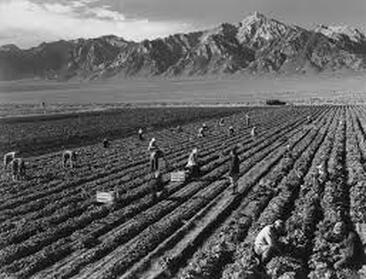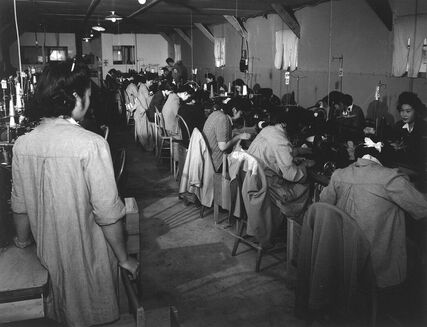|
In light of the primitive living conditions and the ever-present barbed wire and gun towers, what was daily life like for the prisoners of the ten Japanese-American relocation camps?  Conditions and restrictions varied from camp to camp, but one attribute stood out across all the camps: the Japanese internees were extraordinarily resilient, innovative, and self-sufficient considering they were prisoners in their own country. Nowhere was this more evident than when it came to the agricultural output of the camps. The War Relocation Authority overseeing the camps required all the camps to raise most of their own food. In part, this was because the WRA was sensitive to public perception that the government was “coddling” the prisoners. Considering the inhospitable land where the WRA had plunked down the camps, raising most of their food was no easy task. Fortuitously, nearly half of the internees were farmers before the federal government pushed them off their lands into camps. And good farmers at that. Take Camp Manzanar in rural California. The land was basically desert. Yet within a year of its opening, the prisoners had raised enough food crops—melons, tomatoes, sweet corn, apples, pears, and much more—to fill their storehouses. They shipped excess crops to other camps. They and the other camps also raised livestock. Camp Amache in Colorado produced bumper crops of potatoes and other produce they sold to the other camps—despite local farmers insisting it couldn’t be done. Their surplus even helped feed the U.S. Army. Ironically, their former rich farms along the West Coast, grabbed up at fire-sale prices by eager whites, declined in productivity.  One Pariah Job While agriculture employed the majority of labor in the camps, internees worked in other capacities as well. Sixty of them served in the Camp Amache police department, overseen by a white security officer. Three crews of firefighters were overseen by white supervisors. Internees worked as teachers (alongside Caucasians), medical personnel in the hospital, dental technicians, cooks in mess halls, postal employees, librarians, and in co-ops selling personal necessities such as toothpaste and razors. Camp Amache produced its own twice-weekly newspaper, Granada Pioneer. It included a popular comic strip created by a former Walt Disney illustrator about a small boy living in the camp. Perhaps the most unusual work employed 45 internees at Camp Amache’s silkscreen shop. They turned out calendars, program announcements, and other personal-use items for internees. They also churned out training materials and over 250,000 posters for, if you can imagine, the U.S. Navy. Some worked for camp administrations, a job often viewed reproachfully by fellow internees—an element I use in my plot for The Big Dive. Those who worked for the administration or were suspected “informers” often were viewed as inu or dog. In some cases, they were beaten. Whatever their work, the pay was poor, and internees had to pool their money to make certain purchases. Churches, Boy Scouts, and “Rehabilitation” When the incarcerated were not working, the recreation barracks served as home to Boy Scout and Girl Scout troops, the YMCA, nursery schools, movies and theater, concerts and clubs, sports programs, and classes in Japanese calligraphy and flower arranging. They also served as churches for Buddhists, Christians, and other faiths. Despite their shameful imprisonment by a nation they called home, the prisoners formed an American Legion Post, and the scouts flew the American flag at meetings. In short, they did what they could to create as normal a life as possible. As a final insult, and with total lack of irony, impressed WRA authorities crowed over the prisoners’ industrious, self-sufficient attitude. Wrote one administrator, “The long-range program of rehabilitating [my emphasis] the evacuees once again into the stream of normal American life is taking shape . . .” Don't you find that astonishing?
2 Comments
Sharon Jacobs
8/21/2019 02:09:54 pm
Excellent! And, as is customary when I read you 'stuff", I learn so much. Thank you.
Reply
Leave a Reply. |
Bruce Most is an award-winning mystery novelist and short-story writer. His latest novel, The Big Dive, is the sequel to the award-winning Murder on the Tracks, which features a street cop seeking redemption while investigating a string of murders in 1949 Denver. His award-winning Rope Burn involves cattle rustling and murder in contemporary Wyoming ranch country. Bonded for Murder and Missing Bonds features feisty Denver bail bondswoman, Ruby Dark. Archives
February 2022
Categories |

 RSS Feed
RSS Feed